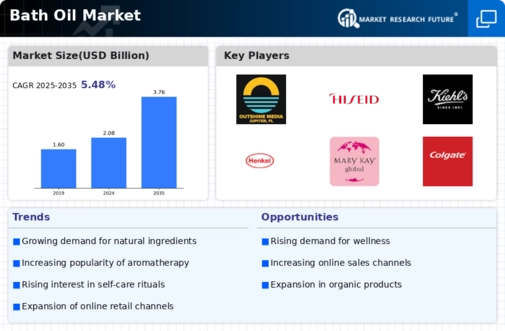Market Growth Projections
The Global Bath Oil Market Industry is projected to experience substantial growth over the next decade. With a market value of 2.08 USD Billion in 2024, it is anticipated to reach 3.76 USD Billion by 2035. This growth trajectory suggests a compound annual growth rate of 5.52% from 2025 to 2035. Factors contributing to this expansion include rising consumer awareness, the growth of e-commerce, and a preference for natural ingredients. As the market evolves, it is likely that brands will continue to innovate and diversify their product offerings to meet the changing demands of consumers.
Rising Consumer Awareness
The Global Bath Oil Market Industry is experiencing a notable surge in consumer awareness regarding the benefits of bath oils. As individuals increasingly prioritize self-care and wellness, the demand for products that promote relaxation and skin health is on the rise. This trend is particularly evident in urban areas where consumers are more inclined to invest in premium bath oil products. The market is projected to reach 2.08 USD Billion in 2024, reflecting a growing recognition of the therapeutic properties of bath oils. This heightened awareness is likely to drive innovation and diversification within the industry, as brands strive to meet evolving consumer preferences.
Growth of E-commerce Platforms
The expansion of e-commerce platforms is significantly influencing the Global Bath Oil Market Industry. With the increasing penetration of the internet and mobile devices, consumers are now able to conveniently purchase bath oils online. This shift towards digital shopping is particularly appealing to younger demographics who prefer the ease of online transactions. As a result, many brands are enhancing their online presence and optimizing their supply chains to cater to this growing demand. The convenience of e-commerce is expected to contribute to the market's growth, potentially leading to a market value of 3.76 USD Billion by 2035, as more consumers opt for online purchases.
Preference for Natural Ingredients
There is a discernible trend towards natural and organic ingredients within the Global Bath Oil Market Industry. Consumers are increasingly seeking products that are free from synthetic chemicals and harmful additives, opting instead for formulations that incorporate essential oils and botanical extracts. This shift is driven by a growing awareness of the potential health risks associated with artificial ingredients. Brands that emphasize transparency in their ingredient sourcing and production processes are likely to gain a competitive edge. This preference for natural products may contribute to a compound annual growth rate of 5.52% from 2025 to 2035, as consumers continue to prioritize health-conscious choices.
Influence of Social Media Marketing
Social media marketing is playing a pivotal role in shaping consumer perceptions and driving sales within the Global Bath Oil Market Industry. Platforms such as Instagram and TikTok have become essential tools for brands to showcase their products and engage with potential customers. Influencers and beauty enthusiasts often share their experiences with bath oils, creating a buzz that can lead to increased brand visibility and consumer interest. This trend is particularly impactful among younger consumers who are more likely to trust recommendations from social media figures. As brands leverage these platforms to connect with their audience, the market is expected to witness substantial growth in the coming years.
Emerging Markets and Demographic Shifts
The Global Bath Oil Market Industry is also benefiting from emerging markets and demographic shifts. As economies in regions such as Asia-Pacific and Latin America continue to develop, there is a rising middle class with increased disposable income. This demographic is more inclined to spend on personal care products, including bath oils. Additionally, the aging population in various countries is driving demand for products that promote relaxation and skin health. As these trends continue to evolve, the market is likely to expand, with brands adapting their offerings to cater to diverse consumer needs across different regions.










